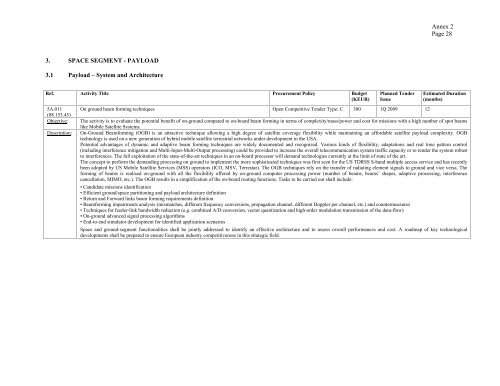ARTES-5.1 â ESA Telecom Technology Workplan ... - Emits - ESA
ARTES-5.1 â ESA Telecom Technology Workplan ... - Emits - ESA
ARTES-5.1 â ESA Telecom Technology Workplan ... - Emits - ESA
- No tags were found...
Create successful ePaper yourself
Turn your PDF publications into a flip-book with our unique Google optimized e-Paper software.
Annex 2Page 283. SPACE SEGMENT - PAYLOAD3.1 Payload – System and ArchitectureRef. Activity Title Procurement Policy Budget(KEUR)5A.011(08.153.45)Objective:Description:Planned TenderIssueOn ground beam forming techniques Open Competitive Tender Type: C 300 1Q 2009 12Estimated Duration(months)The activity is to evaluate the potential benefit of on-ground compared to on-board beam forming in terms of complexity/mass/power and cost for missions with a high number of spot beamslike Mobile Satellite Systems.On-Ground Beamforming (OGB) is an attractive technique allowing a high degree of satellite coverage flexibility while maintaining an affordable satellite payload complexity. OGBtechnology is used on a new generation of hybrid mobile satellite terrestrial networks under development in the USA.Potential advantages of dynamic and adaptive beam forming techniques are widely documented and recognized. Various kinds of flexibility, adaptations and real time pattern control(including interference mitigation and Multi-Input-Multi-Output processing) could be provided to increase the overall telecommunication system traffic capacity or to render the system robustto interferences. The full exploitation of the state-of-the-art techniques in an on-board processor will demand technologies currently at the limit of state of the art.The concept to perform the demanding processing on ground to implement the more sophisticated techniques was first seen for the US TDRSS S-band multiple access service and has recentlybeen adopted by US Mobile Satellite Services (MSS) operators (ICO, MSV, Terrestar). The OGB techniques rely on the transfer of radiating element signals to ground and vice versa. Theforming of beams is realised on-ground with all the flexibility offered by on-ground computer processing power (number of beams, beams’ shapes, adaptive processing, interferencecancellation, MIMO, etc.). The OGB results in a simplification of the on-board routing functions. Tasks to be carried out shall include:• Candidate missions identification• Efficient ground/space partitioning and payload architecture definition• Return and Forward links beam forming requirements definition• Beamforming impairments analysis (mismatches, different frequency conversions, propagation channel, different Doppler per channel, etc.) and countermeasures• Techniques for feeder-link bandwidth reduction (e.g. combined A/D conversion, vector quantization and high-order modulation transmission of the data-flow)• On-ground advanced signal processing algorithms• End-to-end simulator development for identified application scenariosSpace and ground-segment functionalities shall be jointly addressed to identify an effective architecture and to assess overall performances and cost. A roadmap of key technologicaldevelopments shall be prepared to ensure European industry competitiveness in this strategic field.
















